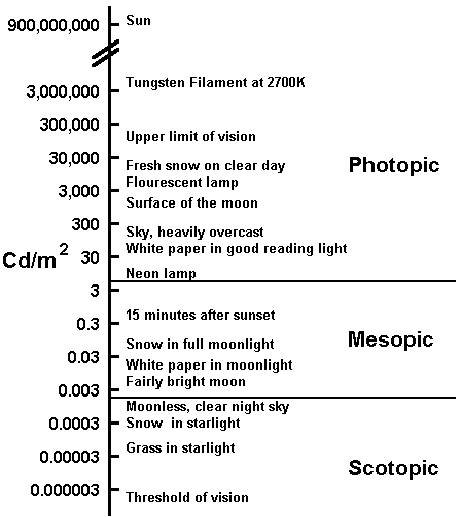Here’s an interesting tid-bit to throw into the mix.
 To use rough numbers, according to this clever Luminance Conversion chart, 3 ftL (foot-lamberts) is 10 cd/m2 (candela per square meter). On the log chart to the left, that is somewhat below the arbitrary line between photopic and mesopic, the line where the eyes shift from a high degree of cone activity to predominantly rod vision. As the website which details this data points out (Visual Expert–Night Vision), among other things, this approach to dark brings a shift that diminishes sensitivity to long wavelength colors (red).
To use rough numbers, according to this clever Luminance Conversion chart, 3 ftL (foot-lamberts) is 10 cd/m2 (candela per square meter). On the log chart to the left, that is somewhat below the arbitrary line between photopic and mesopic, the line where the eyes shift from a high degree of cone activity to predominantly rod vision. As the website which details this data points out (Visual Expert–Night Vision), among other things, this approach to dark brings a shift that diminishes sensitivity to long wavelength colors (red).
One thing we are pretty certain of, from recent discussions, is that;
- some cinemas are pushing to get to 3 ftL behind the glasses, that
- few would know how to measure that, and that
- few would even dare to measure in the seats outside of the sweet spot of a silver screen.
To quote further from the Night Vision site:
“As illumination declines, the visual system starts conserving light in three ways. First, inhibitory responses weaken, and eventually stop. Second, inhibition is replaced by convergence, where the receptor outputs sum together to increase sensitivity but further reduce resolution. Third, there is more available photopigment as light declines. When light strikes a molecule in a photoreceptor, it “bleaches” the molecule, causing electrical activation that leads to a visual sensation. While in the bleached state, it is unresponsive to light. The more photopigment in a bleached state, the less available to respond to light and the lower the sensitivity. In dim light, very little of the photopigment is bleached, so the eye has greater light sensitivity. All of this occurs before and continues after the switch from cones to rods.
“One effect of switching to rods, however, is the “Purkinje shift.” During photopic cones vision, viewers are most sensitive to light that appears greenish-yellow. In scotopic vision, they are most sensitive to light which would appear greenish-blue during the day.”
End of Part 1; Scotopic Issues with 3D, and Silver Screens
Part 2: 23 degrees…half the light. 3D What?
Part 3: